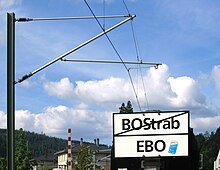Verordnung über den Bau und Betrieb der Straßenbahnen
The Regulation on the construction and operation of the trams - Short title tram construction and operation order ( BOStrab ) - regulates the Federal Republic of Germany the construction and operation of trams. Legal basis for the regulation is § 57 Passenger Transport Act ( Passenger Transport Act ).
Subject Matter
The Regulation applies to trams within the meaning of § 4 Passenger Transport Act. A distinction is made between street railways dependent pursuant to § 4 para 1 PbefG and independent pathways according to § 4 para 2 Passenger Transport Act.
The provisions of BOStrab apply except for trams and elevated and underground railways for monorails as the Wuppertal suspension railway, automated people movers like the Dortmund H-Bahn or the SkyLine at Frankfurt Airport.
The BOStrab describes basic planning requirements and regulates everything regarding management, operating staff, operating facilities, vehicles and operations. These requirements are met in accordance with § 2 BOStrab if they comply with the provisions of BOStrab and the generally recognized rules of technology. A specification of these requirements is made in the BOStrab guidelines. The core policies are the brakes, tunneling, Trassierungs, light space, vehicle and tracking policy. The technical licensing and supervisory authority is determined by the province.
The BOStrab was adopted as the imperial law the first time on November 13, 1937 ( Reich Law Gazette I p 1247 ) - on the basis of § 39 of the Law on transportation of persons by land from December 4, 1934 ( Reich Law Gazette I p 1217 ) (see also passenger Transport Act under Historical development ) and entered into force on 1 April 1938. Until then, there was no Germany -wide scheme, but were each different orders in different countries. The rich legal regulation is passed into federal law. The current version came into force on 1 January 1988.
The construction and operation of other trains is governed by other regulations: The Railway Construction and Operation (EBO ) regulates the construction and operation of standard gauge railways. For narrow-gauge railways, the Railway Construction and Operating Rules for narrow gauge railways ( ESBO ) with similar tasks, applies.
Roadbed
§ 16 defines three different roadbed:
- Flush road roadbed share the same road space as other road users (road, pedestrian).
- Special train body lying in the traffic area of public streets, however, are by structural measures (eg, curbs, guard rails, hedges or rows of trees ) separated from other traffic. Same height crossings with the other traffic is marked as level crossings part of the special railway track when used with a St. Andrew's cross ( Highway Code 201 characters ) and 20 are technically secure under the provisions of § at least with a light character.
- Independent roadbed are those routes that are independent due to their location or their design from other traffic. Crossings are part of the independent rail body.
Paths on straßenbündigem roadbed be part of the road and are therefore the road traffic regulations subject. You must adhere to the same speed as the rest of road transport and be equipped with direction indicators and rear view mirror. The BOStrab sets a maximum length of 75 m and a maximum width of 2.65 m for participating on -road vehicles. The regulations shall apply to paths on special roadbed in respect of such intersections that do not meet the requirements of § 20.
Flush road roadbed are typical feature of trams. Urban railways have special roadbed in their above-ground sections in the rule. Subways are equipped throughout with independent rail tracks.
After the Municipal Transport Financing Act new lines can only be funded if they receive at least special roadbed.
Signals
For the journey in accordance BOStrab there are special signals that are more particularly described in § 51 and in Annex 4. For details, see main article tram signals in Germany.
Arrangements for passengers
Specific and independent roadbed may not enter except by operating personnel and to cross only at level crossings in accordance with § 58.
According to § 63 BOStrab it provides to passengers is a legal offense if they operate outside doors or emergency brakes abusive or enter operating systems or vehicles without authorization.









